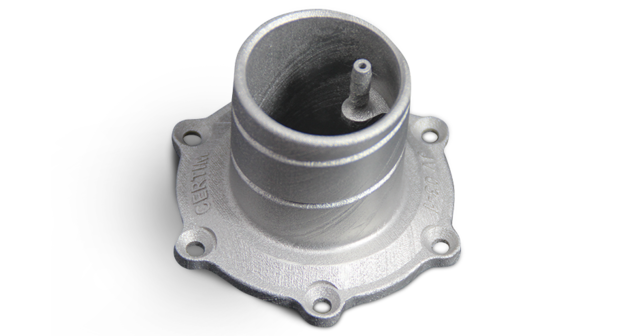Partial Hand Prosthetics Company Scales Manufacturing with Help from 3D Systems
Designs is an innovator in the field of partial hand prosthetic design and provides robust artificial digit solutions through a combination of additive manufacturing (AM), mechanical design, and clinical care. Founded by researchers out of the Bio mechatronics Development Laboratory at the University of Colorado, Point Designs needed manufacturing support when demand for its products outpaced in-house capacity. By selecting 3D scanning services in India, Systems as its production partner, Point Designs solved its supply issue and advanced its product development process. Through close collaboration with 3D Systems’ experts, the company transitioned from steel to titanium in just six months, gaining workflow efficiencies and valuable knowledge to advance its portfolio.
PARTNER TO SCALE AM PRODUCTION OF PARTIAL HAND
PROSTHETIC COMPONENTS
With
early access to lab resources at the University of Colorado, Point Designs
created its Point Digit solution with metal 3D printing in India
mind from the very beginning. As the solution gained popularity, however, the
company needed a partner to help grow its capacity. 3D Systems’ track record in
medical device manufacturing, expertise in high quality, repeatable titanium
printing, and intimate knowledge of AM technologies and processes guided Point
Designs’ decision. Together, the companies adapted the Point Digit solution to
titanium and fast-tracked it’s time-to-market to achieve functional, aesthetic,
and optimized product components.
Collaboration to Advance Design for Additive Manufacturing
When
Point Designs engineered its Point Digit solution, it took advantage of the
benefits of design for additive manufacturing (DfAM) by creating organic
shapes, semi-hollow structures, and assemblies in situ. These types of features
are uniquely enabled by AM and are a compelling reason for many to use the
technology, enabling parts to be designed specifically for their intended
function, at reduced weight, and with reduced assembly. However, achieving a
successful 3D print can be tricky, especially when the final product entails
detailed mechanisms which require strict tolerances.
One
key AM-enabled feature that Point Designs uses is a live hinge, which is
printed as an assembly in situ and allows rotation for more natural movement.
Sliker says the ability to print this assembly in place is an incredible
benefit because the hinge components are not only small, but they are internal
components. “To assemble them any other way would be difficult, if not
impossible,” says Sliker. “Not only would it be time-consuming, but you’d have
to keep track of some really tiny parts. Printing everything in place with a
live hinge really simplifies our assembly and manufacturing.”
Consultation for Optimized Print Strategy for Mass Production
Despite the short timeline to product launch, Point Designs had some design-related challenges to overcome when it started its work with 3D Systems service partners in India, in particular when it came to part orientation. Point Designs had selected its existing build orientation to accommodate the critical dimensions and tight tolerances of its final parts. However, this orientation was not optimized for scaled production. 3D Systems and Point Designs worked together to devise a new print strategy that would enable substantially more parts to be printed in a single build while taking downstream processes into account. To avoid support scarring on critical surfaces, the two companies worked together to come up with support structures that would be easy to remove, as well as post-processing techniques to deliver the desired finish on those surfaces.
Transition to Premium Titanium Material
When Point Designs was searching for a
manufacturing partner, its primary concern was capacity. By selecting 3D
Systems, Sliker says it gained titanium as a bonus. But Point Designs is not
the only one benefitting. Jeff Solberg is an end-user of the Point Digit
solution and has worn both the steel and titanium versions. With a 30%
reduction in weight enabled by the new material, the difference was instantly
noticeable.
Reduced Assembly
3D
Systems collaborate on four products, each comprised of multiple 3D printed
components and available in multiple sizes for a total of 17 SKUs and 107
unique components. Once Point Designs receives the printed parts from 3D
Systems, they are assembled by the Point Designs team using a combination of
off-the-shelf and customized components. Following assembly, Point Designs
delivers its products to a prosthetist, which creates a custom prosthetic
socket for each recipient.
In
terms of solving its supply issue, Griffin , business development specialist at
Point Designs, says that since working with 3D Systems, the companies have
established a reliable production cadence and Point Designs hasn't since
experienced any back-ordered products, which is a meaningful and welcomed
achievement. This has been possible through the close and open communication
between Point Designs and 3D Systems, allowing each to have visibility into the
other’s timelines for accurate forecasting and planning. Following the
successful launch of Point Digit 2.0, a Class I medical device, Point Designs
is now pursuing numerous other prosthetic offerings which will leverage 3D
Systems’ expertise.
For
more information about 3d scanners & haptics visit: https://www.mavericsolution.com/scanners.html




Comments
Post a Comment